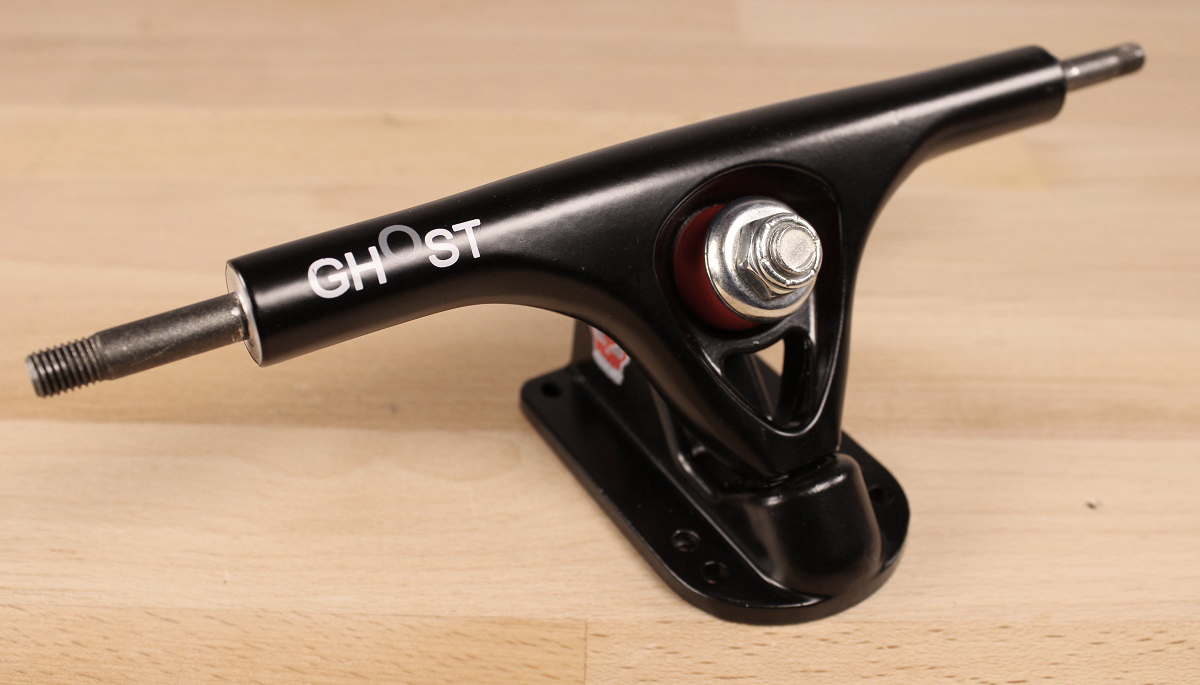The Ultimate Guide to Longboard Trucks. A longboard’s trucks are what drive the board. In other words, trucks determine how your board feels. Axle width, base plate height, kingpin angle, bushing durometer ratings — these technical specifications make up a truck. But what does it all mean, and how exactly does it determine performance? Let’s review.
The Parts of a Longboard Truck, Explained

First, let’s break down the components of a longboarding truck. Then we’ll cover the specifications for each, and how they affect performance.
1. Axle/Hanger. The axle hosts the wheels. On either side of the axle are axle shafts. These shafts host the wheels’ bearings, and the wheel nuts. The tall, triangular center section of the axle, which contains the axle shafts, pivot, and bushing seat, is called the hanger.
2. Base Plate & Kingpin. The base plate connects the axle to the board, while the kingpin — the angled, threaded shaft atop the plate — connects the axle to the base plate. The truck bushings (3) seat on the kingpin.
The hole at the bottom front of the base plate is the pivot cup, which serves as a second connecting point between the axle and plate. The pivot cup and kingpin allow the axle to rotate from side to side. This rotating action is what steers the longboard.
3. Main Bushing & cone Bushing. These two bushings dampen the axle’s movement. When installed, the bushings are tightened and compressed by the kingpin nut. This compression applies a mild, constant spring force against the axle. This spring force both stabilizes the axle, preventing “death wobble” at high speed, and assists the axle in returning to a neutral, forward-facing position.
4. Kingpin washers. The kingpin washers seat on the outer most ends of the main bushing and cone bushing, distributing the compressive force of the kingpin nut through both bushings.
Now you’ve got a basic understanding of the parts of a longboard truck, and what they do. But the size, shape, angle, and hardness of these components also play a key role in performance.
Let’s break down how these specs affect your ride, and what’s best for certain riding styles.
Axle Width: What’s Best?
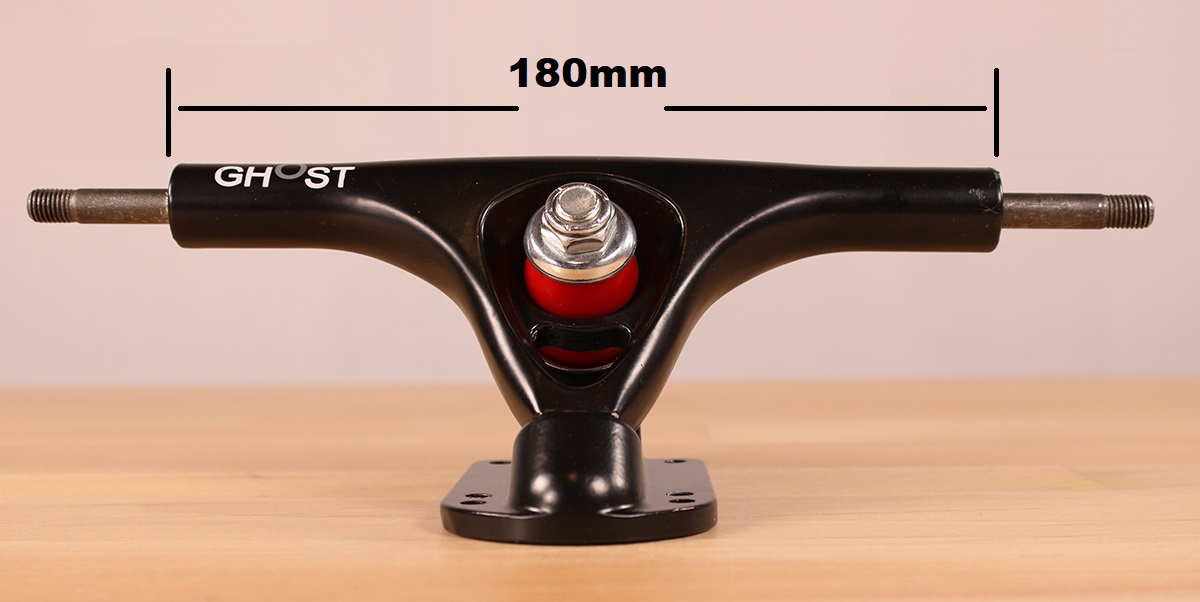
Truck width — more correctly, axle width — plays a key role in determining straight-line stability and turning radius. There are a few hard n’ fast rules to know about axle width:
- Wider axles produce a wider turning radius, and higher stability
- Narrower axles produce a tighter turning radius, with lower stability.
- Generally, your axle width should closely match the width of your board’s deck.
For beginner riders, and for longboard riders who prefer a well-rounded, “do-it-all” setup — in other words, a board that’s both stable at high speed, but still responsive for tight carving — a 180mm axles work best. That’s why we use this width as our default truck width on most Ghost Boards.
If you’re looking for an even more responsive setup, 150mm axles work best. This axle width isn’t well-suited for downhill runs and high-speed cruising, but it’s excellent for free riding urban areas with tight, crowded streets.
For surfskates, the standard axle width is 165mm. Surfskaters like to ride fast and carve quick. This axle width has been found to provide the best compromise between high-speed stability and turning ability on these short, wide boards.
(A Note on Truck Width Measurements)
Some trucks may advertise width measurements in inches. This usually refers to the full width of the truck, including the axle shafts. When measurements are displayed in millimeters (like above), it’s usually referring to the width of the hanger, minus the shafts. Keep this in mind when picking out trucks.
All About Kingpin Angles
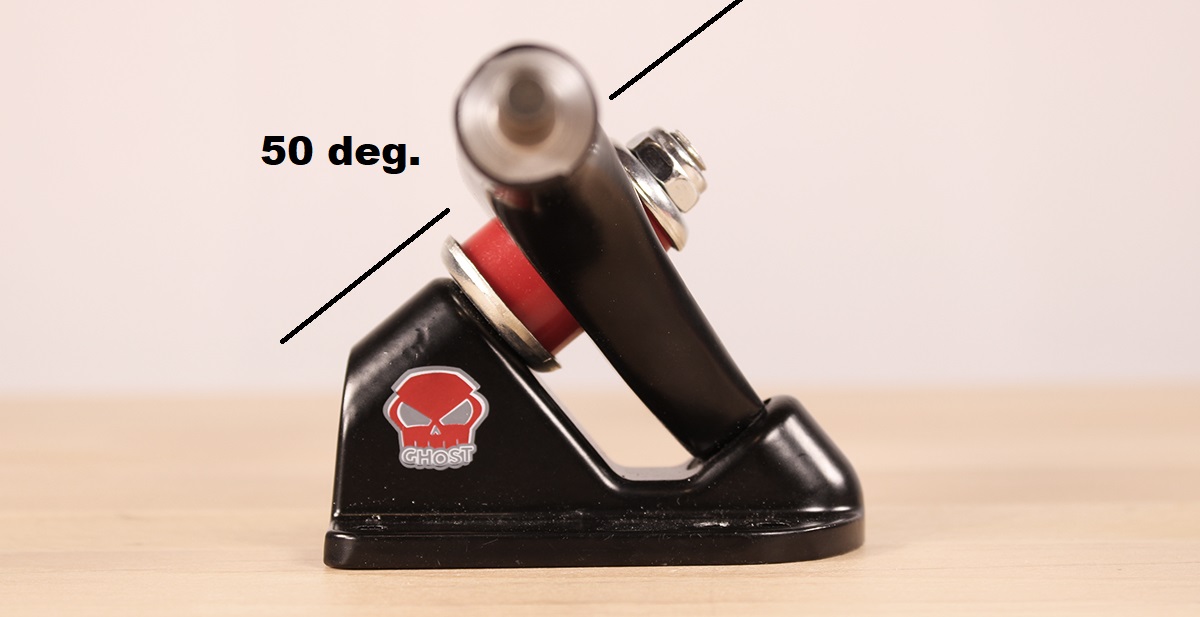
Kingpin angle — sometimes called base plate angle — also contributes significantly to the truck’s responsiveness and stability. To keep things simple, most longboard trucks come with a 50-degree, “high angle” kingpin.
In the greater skate world, this is considered a high-degree truck. This high angle is partly why standard longboard trucks are configured with reverse kingpins (more on that later).
This 50-degree angle makes the truck ride high, increasing the available leverage when carving, and producing a tighter turning radius with less rider input. In other words, the higher the angle, the “snappier” and more responsive the truck, and the easier it is to turn at low speeds.
Some longboards come with 44-, 42-, or 40-degree (“low angle”) trucks. These are typically reserved for high-speed riding and downhill bombing, because these lower angles sacrifice tight turning for increased stability. The faster you ride, the less input is required to turn, so the compromise is negligible for this riding style.
Lastly, some advanced downhill riders prefer a split-degree truck setup. With this setup, both trucks have the same kingpin angle. But the rear truck also utilizes an angled base plate, which increases the overall angle of the rear kingpin, relative to the front.
This split-degree setup is specifically designed to mitigate a potentially dangerous situation: At very high speeds, the rear truck can start “back steering,” also called rear steer. Rear steer is what contributes to death wobbles.
Longboard Bushings Explained
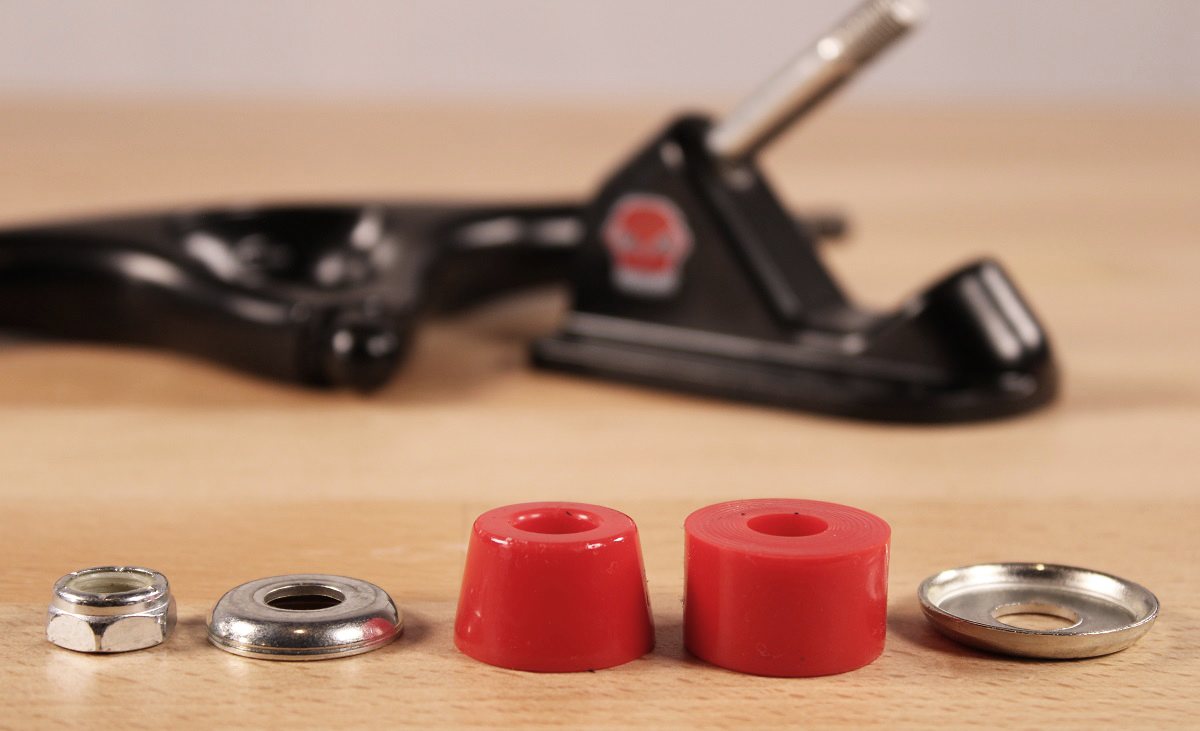
When it comes to dialing in your trucks’ performance, bushings are often overlooked. They are deceptively simple in appearance — but their shape, height, and durometer rating (hardness) can greatly influence how your board handles.
Bushing Hardness
Bushing hardness ranges from 78a (soft) to 98a (hard). In between, you’ve got 84a to 90a, which are considered good, “do-it-all” hardness ratings. The softer the bushing, the more responsive the board — but you’ll have less stability at high speed.
The harder the bushing, the less responsive your turning will be, with higher stability at speed. (Our Ghost Boards come with 90a bushings.)
Bushing Shape & Height
Bushings are categorized by four shapes:
- Tall cone
- Short cone
- Tall barrel
- Short barrel
Cone bushings provide greater leverage and turning ability, making them ideal for responsive setups and low-speed carving. Barrel bushings are designed to promote stability, making them best for high-speed cruising and downhill runs.
Bushing height also contributes, here: Tall bushings produce greater leverage. They can be compressed more, improving responsiveness, while short bushings compress very little, promoting high stability and low responsiveness — again, picking one or the other depends entirely on whether you prefer responsiveness, or stability.
(Here Lies The Great Bushing Debate)
You could play around endlessly with longboard bushing shape, height, and hardness. A soft barrel bushing might actually provide tighter carving and better responsiveness than a hard cone bushing.
To keep things simple for most riders, we recommend starting with a combination bushing setup: Use a medium-hard (84a to 90a) barrel bushing on the board side of the truck and a tall, medium-hard cone bushing on the base plate side.
In most cases, riders can adequately tune their bushings just by tightening or loosening the kingpin nut.
The Bushing Seat
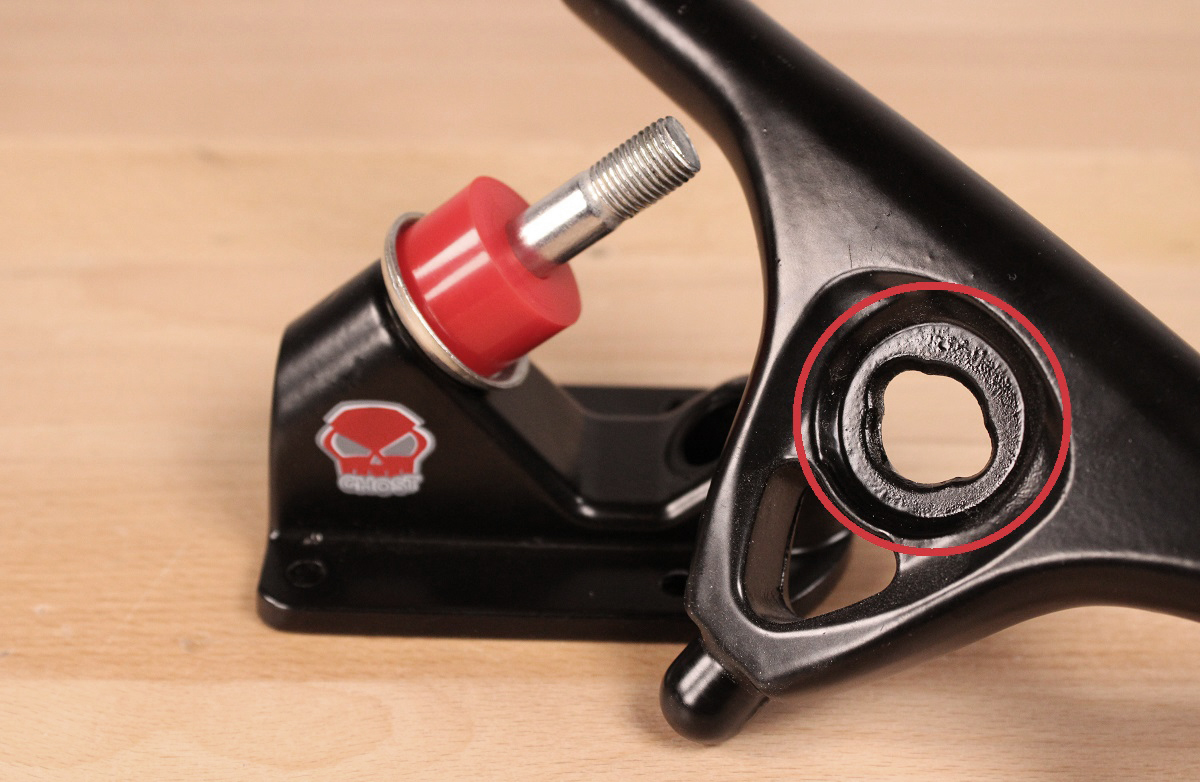
The pocket on the hanger, surrounding the kingpin hole, is called the bushing seat. This seat rests against one side of both bushings, and it, too, can play a smaller role in handling and performance.
Bushing seats can be cut with hard angles, promoting a tighter fit between the bushings and hanger, or they can be cut with rounded, sloping edges, that provide more leverage.
- A tight bushing seat promotes stability and reduces responsiveness.
- A looser, rounded seat promotes responsiveness, and less stability.
For casual riders, street cruisers, and “do-it-all” setups, you’ll find rounded or looser bushing seats on most longboard trucks.
Reverse Kingpin vs. Standard Kingpin
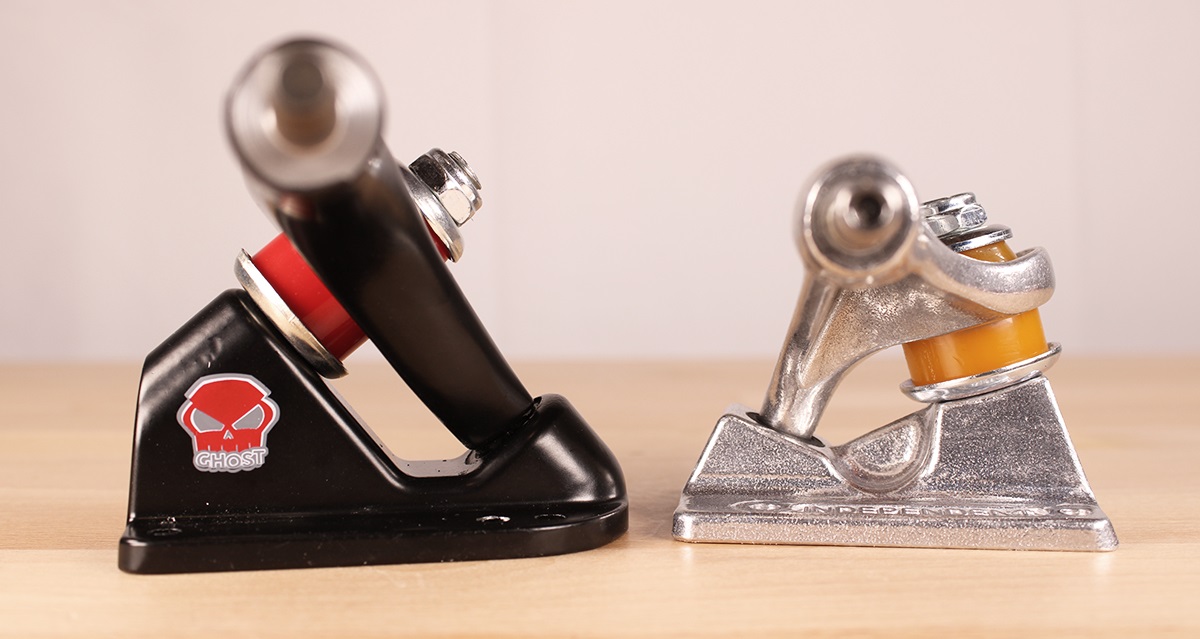
Remember that we mentioned high-angle trucks requiring a reverse kingpin setup?
Reverse kingpin trucks are found on most longboards (left), while standard kingpin trucks (right) are typically reserved for skateboards.
Reverse kingpins increase the height between the wheels and board, and they shorten the wheelbase. The added height and shorter wheelbase promote carving ability and improve responsiveness at low speeds.
Standard kingpins, often referred to as “SKP” trucks, sit lower to the ground, making them better suited for small skate wheels and smaller decks.
Want to know the differences between longboard and skate trucks? Read this guide!

